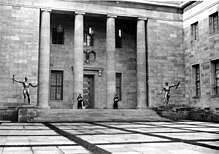Nazi architecture
.jpg)
Nazi architecture is the architecture promoted by the Third Reich from 1933 until its fall in 1945. It is characterized by three forms: a stripped-down neoclassicism (typified by the designs of Albert Speer); a vernacular style that drew inspiration from traditional rural architecture, especially alpine; and a utilitarian style followed for major infrastructure projects and industrial or military complexes. Nazi ideology took a pluralist attitude to architecture; however, Adolf Hitler himself believed that form should follow function and wrote against "stupid imitations of the past".[1]
The crowning achievement of this movement was to be Welthauptstadt Germania, the projected renewal of the German capital Berlin following the Nazis' victory in World War II. Speer, who oversaw the project, produced most of the plans for the new city. Only a small portion of the "World Capital" was ever built between 1937 and 1943. The plan's core features included the creation of a great neoclassical city based on an East-West axis with the Berlin victory column at its centre. Major Nazi buildings like the Reichstag or the Große Halle (never built) would adjoin wide boulevards. A great number of historic buildings in the city were demolished in the planned construction zones. However, with defeat of the Third Reich, the work was never started.
Architectural proponents

- Hermann Bartels
- Peter Behrens
- German Bestelmeyer
- Paul Bonatz
- Woldemar Brinkmann
- Walter Brugmann
- Richard Ermisch
- Gottfried Feder
- Roderich Fick
- Theodor Fischer
- Leonhard Gall
- Hermann Giesler
- Wilhelm Grebe
- Fritz Hoger
- Eugen Honig
- Clemens Klotz
- Wilhelm Kreis
- Werner March
- Konrad Nonn
- Alfred Rosenberg
- Ludwig Ruff
- Franz Ruff
- Ernst Sagebiel
- Paul Schmitthenner
- Julius Schulte-Frohlinde
- Paul Schultze-Naumburg
- Alexander von Senger
- Albert Speer
- Fritz Todt
- Paul Troost
- Rudolf Wolters
See also
References
- ↑ Nazi architecture, in "Oxford Dictionary of Architecture and Landscape Architecture", 2006, p518.
Bibliography
- Baynes, Norman H., ed. (1942). The Speeches of Adolf Hitler, April 1922-August 1939. Two vols. London: Oxford University Press.
- Brenner, Hildegard (1965). La politica culturale del nazismo [Die Kunstpolitik des Nationalsozialismus (Art policies of Nazism)] (in Italian). Translated from German by Enzo Collotti. Bari: Laterza.
- Cowdery, Ray; Cowdery, Josephine (2003). The New German Reichschancellery in Berlin 1938-1945. Victory WW2 Publishing. ISBN 978-0910667289.
- De Jaeger, Charles (1981). The Linz file: Hitler's plunder of Europe's art. Exeter: Webb & Bower. ISBN 9780906671306.
- Dülffer, Jost; Thies, Jochen; Henke, Josef (1978). Hitlers Städte: Baupolitik Im Dritten Reich. Eine Dokumentation [Building Policies in the Third Reich] (in German). Köln: Böhlau. ISBN 3-412-03477-0.
- Giesler, Hermann (1977). Ein Anderer Hitler: Bericht Seines Architekten Erlebnisse, Gesprache, Reflexionen [A Different Hitler: Report on its Architects' Experiences, Conversations, Reflections] (in German). Druffel. ISBN 978-3806108200.
- Helmer, Stephen (1985). Hitler's Berlin: The Speer Plans for Reshaping the Central City (Illustrated). Ann Arbor: UMI Research Press. ISBN 0-8357-1682-1.
- Hitler, Adolf (1971). Mein Kampf [My Struggle]. Translated by Ralph Manheim. Houghton Mifflin. ISBN 978-0395078013. In Internet Archive (1941 edition by Reynal & Hitchcock, New York).
- Hitler, Adolf (2000). Hitler's Table Talk 1941-1944: His Private Conversations. Translated by Norman Cameron and R.H. Stevens. New York: Enigma Books. ISBN 1-929631-05-7.
- Homze, Edward L. (1967). Foreign Labor in Nazi Germany. Princeton University Press. ISBN 0-691-05118-6.
- Jaskot, Paul B. (2000). The Architecture of Oppression: The SS, Forced Labor and the Nazi Monumental Building Economy. New York: Routledge. ISBN 978-0415223-416.
- Krier, Leon (1989). Albert Speer Architecture. New York: Princeton Architectural Press. ISBN 2-87143-006-3.
- Lärmer, Karl (1975). Autobahnbau in Deutschland 1933 bis 1945 [Highway construction in Germany 1933-1945] (in German). Berlin: Akademie Verlag. ASIN B001UWP0DY.
- Lehmann-Haupt, Hellmut (1973). Art under a Dictatorship (Illustrated). New York: Octagon Books. ISBN 0-374-94896-8.
- Lehrer, Steven (2006). The Reich Chancellery and Fuhrerbunker Complex: An Illustrated History of the Seat of the Nazi Regime. McFarland & Co. ISBN 978-0786423934.
- Mittig, Hans-Ernst (2005). "Marmor der Reichskanzlei". In Bingen, Dieter; Hinz, Hans-Martin. Die Schleifung: Zerstörung und Wiederaufbau historischer Bauten in Deutschland und Polen [The Razing: Destruction and Reconstruction of Historical Buildings in Germany and Poland] (in German). Wiesbaden: Otto Harrassowitz. ISBN 3-447-05096-9.
- Nerdinger, Winfried (1999). Bauhaus-Moderne im Nationalsozialismus [Modernist Architecture in Nazi Germany] (in German). Prestel. ISBN 978-3791312699.
- Petsch, Joachim (1976). Baukunst Und Stadtplanung Im Dritten Reich: Herleitung, Bestandsaufnahme, Entwicklung, Nachfolge [Architecture and urban planning in the Third Reich: Origin, Inventory, Development, Follow-up] (in German). C. Hanser. ISBN 978-3446122796.
- Rittich, Werner (1938). Architektur und Bauplastik der Gegenwart [Plastic Figures in Modern Architecture] (in German). Berlin: Rembrandt Verlag.
- Schönberger, Angela (1981). Die Neue Reichskanzlei von Albert Speer. Zum Zusammenhang von nationalsozialistischer Ideologie und Architektur [The New Reich Chancellery by Albert Speer. To a Coherence between Nazi Ideology and Architecture] (in German). Berlin: Gebrüder Mann. ISBN 978-3786112631.
- Scobie, Alexander (1990). Hitler's State Architecture: The Impact of Classical Antiquity. College Art Association Monograph - Book 45. Pennsylvania State University Press. ISBN 978-0271006918.
- Schmitz, Matthias (1940). A Nation Builds: Contemporary German Architecture. New York: German Library of Information. Lay summary – questia.
- Speer, Albert (1970). Inside the Third Reich. Translation by Richard and Clara Winston. New York: Macmillan. ISBN 0-02-037500-X. In Internet Archive.
- Spotts, Frederic (2002). Hitler and the Power of Aesthetics. Woodstock, New York: Overlook Press. ISBN 1-58567-345-5.
- Taylor, Robert (1974). The Word in Stone: The Role of Architecture in the National Socialist Ideology. Berkeley: University of California Press. ISBN 0-520-02193-2.
- Thies, Jochen (1976). Architekt der Weltherrschaft. Die Endziele Hitlers [Architect of world domination. The ultimate goals of Hitler] (in German). Düsseldorf: Droste. ISBN 978-3770004256.
- Zoller, Albert (1949). Hitler privat. Erlebnisbericht seiner Geheimsekretärin [Hitler's Private Secretary Testimony] (in German). Düsseldorf: Droste. ASIN B0023S7QZO.
External links

- A Theory of Ruin-value , Cornelius Holtorf, last updated on 21 December 2004.
- A Teacher's Guide to the Holocaust website:
- NS-Architektur at LEMO - Lebendiges Museum Online.